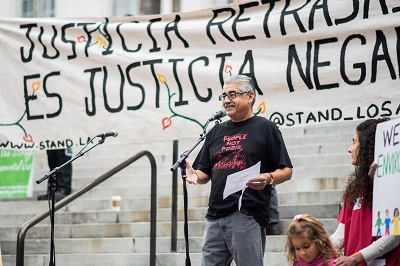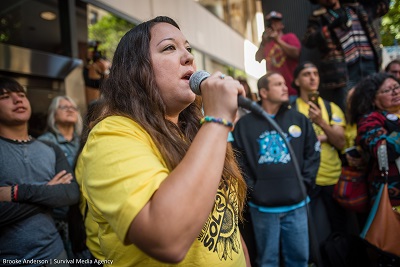
In the Los Angeles neighborhood of University Park, west of downtown and east of the University of Southern California campus, people felt ill. Residents and those who spent time at the schools, libraries, and shops in the area were getting nosebleeds, headaches, and feeling shortness of breath.
This neighborhood of South-Central Los Angeles was about to join a familiar fight—one against the fossil fuel industry in their own backyards. These fights are often spearheaded by communities of color, as their historical lack of power means they’re more likely to be stepped on by dirty industries and ignored by government regulators as pollution and other types of foul play seep into their neighborhoods. In this story, we meet environmental justice leaders in two such communities who refuse to be silenced.
Drilling in the City of Angels
You wouldn’t expect to find an active oil well downtown in one of the country’s largest cities, but it’s common. LA has been home to productive oil operations since 1890. The city has thousands of active wells—580,000 Angelenos lives within a quarter mile of an active oil well, according to Stand Together Against Neighborhood Drilling L.A. (STAND-LA), a coalition of environmental justice groups that seeks to end all drilling in the area.
When people in University Park started feeling sick in 2013, Esperanza Community Housing, a community development nonprofit that owns affordable housing units, organized 350 community members to write official complaints to the South Coast Air Quality Management District. Regulators who showed up to investigate found an active oil well with a leak.
“It’s our understanding that 70 percent of the oil drilling sites that are in sensitive land areas are in communities of color—principally Black and Brown communities bear the brunt of this,” says Hugo Garcia, campaign coordinator for People Not Pozos (People Not Oil Wells), a campaign run by Esperanza Community Housing. “It’s an environmental justice issue as well as a public health issue.”

STAND-LA Finds its Footing
University Park’s well is operated by an extraction company called AllenCo Energy, which ramped up production by 400 percent after taking over the site in 2009, according to Garcia. The land the well is on, however, is owned by the Archdiocese of Los Angeles, which stayed silent, even after community members sent a video to the Pope in which they pleaded to him to shut down the site.
One of those community members was Nalleli Cobo, who started to feel chest pains in third grade while living across the street from the site in an apartment with her sister, mother, grandmother, and great grandmother. Cobo’s mother, Monic Uriarte, works for Esperanza Community Housing, so naturally the family joined the People Not Pozos fight.
“Nalleli has been involved in this fight since she was little,” Uriarte said in an interview with Univision in 2016. “She lived the consequences of pollution and she realized that it was unfair. My daughter knows how to speak out and is not afraid to fight for the welfare of our community.”
The community mounted a pressure campaign joined by other groups fighting the oil industry in their own neighborhoods to form the STAND-LA coalition. When the Los Angeles Times investigated the story, it published a picture of a toddler with a bloody nose, causing alarm across the area.
“And then all of a sudden it changed the regulators who had been pretty much asleep at the wheel,” says Garcia.
It took years of pushing the city, including more reports of health problems and air pollution, demonstrations, community meetings, and canvassing. The city finally hired a petroleum administrator, a position that had been unfilled in the government for 40 years. Garcia was hopeful when an inter-agency group convened in 2018 to facilitate information between regulators, key agencies, and the community, but was disheartened when selected regulators and agencies were invited but the community was not. But finally, he was allowed to attend to represent University Park residents.
Victory for Esperanza
On March 5, 2020, regulators ordered AllenCo Energy to plug its wells and decommission its oil drilling site in University Park. This order is pending an appeal filed by the company.
But the fight isn’t over. Garcia says cleanup of the contaminated site is of utmost importance. He hopes the site will be decontaminated and re-purposed into a facility that benefits the community, like affordable housing or recreation space.
People fighting Big Oil in LA are not alone. For Native Americans in rural North Dakota, the enemy is fracking.
Fracking in the Bakken
Underneath the Fort Berthold Reservation and spanning 200,000 square miles from North Dakota to Montana and Canada lies the Bakken shale formation. With its billions of gallons of crude oil, the area became an epicenter for hydraulic fracking and the second largest oil producer in the US in less than a decade. That has repercussions for Native American peoples who must live next to the steady ecological destruction of their land.
Kandi White of the Mandan, Hidatsa, and Arikara Tribes is a Native organizer and the climate and energy campaign coordinator for the Indigenous Environmental Network. She grew up in a community called New Town on the Fort Berthold Indian Reservation, about 100 miles down the Missouri River from Williston, the fracking hub of North Dakota.
“When I was 20, I got diagnosed with cancer. It was a stage four sarcoma tumor,” says White. “A lot of people around me had cancer. A lot of people still do have cancer. At the time, I just thought that was normal.”
This is a common experience for Native Americans, who have a disproportionately high disease burden and lower life expectancy than other Americans, according to the US Department of Health and Human Services. Their exposure to pollution is much higher than other groups because of the way that First Nations were designated land by the government in the form of reservations; unable to move, industrial development industries set up, putting Native populations at risk.
“There’s no law that is on our side,” says White. “It’s never been more clear than it was at Standing Rock that the laws been twisted to make sense only for those people that it benefits.”

Native Women in Danger
The explosive growth of fracking jobs outside of the reservation has attracted tens of thousands of new residents, most of them men. Workers are housed in mobile home complexes called “mancamps” and conditions are so bad that, according to North Dakota’s Uniform Crime Reports, murder, aggravated assault, rape, and robbery increased by 125 percent between 2005 and 2013.
For Native women, the fracking industry has brought violence. Williston’s rape rate is nearly four times the national average and a Native woman is seven times more likely to be raped than a woman living in New York City according to an article from Portland State University. White expresses that many in her community at the Fort Berthold Reservation feel cornered to the point that activists and tribal leaders are in disagreement.
“We’re fighting against our own tribal councils,” she says. “We’re fighting against our own people that are like, ‘They’re going to take it from us anyways, based on our history: they gave us diseases, they killed off our numbers, they put us on reservations, they built a dam that flooded our lands. We cannot win. We might as well take the money.’”
People’s Rights and Climate Change
Despite these challenges, White continues to promote Indigenous rights and environmental justice.
“We have to keep moving forward and protecting our Native nations and protecting our elders and protecting our identities and our lifeways,” White says. “I want people to not get stuck in apathy. I want them to understand that they can do things to empower themselves.”
Climate science is nearing First Nations’ understanding of ecological balance—Project Drawdown lists Indigenous knowledge as a solution to the climate crisis.
“It’s funny to see scientists catching up now with what we’ve always known just by being land-based people,” says White. “It was always an urgent conversation to say you cannot do this, you cannot practice a capitalistic model because it will come back to harm us as humanity.”
To support Indigenous resistance, demand megabanks end fossil fuel financing. Goldman Sachs may have caved to the Gwich’in nation’s demands to end funding of oil drilling in the arctic refuge, but banks are still financing fossil fuels in the Bakken and elsewhere. Tell JPMorgan Chase to stop funding fossil fuels.
From Los Angeles, Garcia reminds us that organizers’ have one of the biggest jobs in their communities. He urges other community organizers, whether they’re fighting fossil fuel companies or other environmental justice fights, to keep a clear head as they lead their communities, hopefully, to victory.
“It is the organizers task to bring light, to lift up and bring clarity to strategic, tangible issues that provide compelling incentive for the community to organize,” says Garcia. “After all, in any campaign, it’s a grasp of one’s objective living condition, and what it can be, that dictates the impetus for residents to organize. It’s all about: ‘Dare to struggle—dare to win.’”







